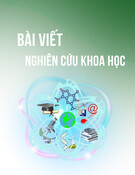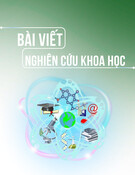
Tạp chí Khoa học Ngôn ngữ và Văn hóa
ISSN 2525-2674
Tập 7, số 3, 2023
289
PATTERNS OF VIETNAMESE-ENGLISH CODESWITCHING:
A CASE OF A VIETNAMESE TV SHOW
Dong Ngoc Minh Thu; Ngo Le Hoang Phuong
University of Foreign Languages and International Studies, Hue University
mthudong18199@gmail.com
(Received: 14/09/2023; Revised: 18/11/2023; Accepted: 01/12/2023)
Abstract: Codeswitching has remarkably drawn interest from many linguists around the
world. However, the amount of research in Vietnamese-English codeswitching is still limited
and few of them have studied this phenomenon in Vietnamese TV shows. Therefore, this
paper aims to examine the patterns of codeswitching instances in a Vietnamese TV show
called “Người Ấy Là Ai” (Who is Single?). Data presented in this paper was gathered from
a 138-minute episode in the show and then analysed based on the framework of Poplack
(1980). It was found that the speakers employed different types of CS, among which
intrasentential switches being the most popular compared to other categories. Some
implications for the appropriate uses of codeswitching in the mass media industry will also
be mentioned.
Keywords: Sociolinguistic, codeswitching, patterns, typology, intersentential, intrasentential,
tag switching, TV show, Vietnamese language
1. Introduction
Codeswitching (CS) - the process of switching languages within a single conversation -
has attracted the attention of a number of researchers. In different contexts, the switch between
English and another language has been observed, such as in countries where English is a native
language, such as Canada or Australia, or in countries where English is a foreign language, such
as Vietnam. However, there has been little research exploring CS within the Vietnamese context.
As a contribution to the burgeoning field of Vietnamese-English CS research, this article
investigates code-switched instances found in the top-rated TV show “Người Ấy Là Ai?" (Who's
single Vietnam), which airs on Vie Channel. The study aims to establish a comprehensive
understanding of CS in the Vietnamese context, particularly in Vietnamese TV shows.
2. Literature review
2.1 Definition
The term “codeswitching” (CS) has been defined differently in the existing literature. For
example, Blom and Gumperz (1972) considered CS as an act when a speaker switches to another
language during a conversation and does not switch back after a significant period of time or does
not switch back at all. Meanwhile, Jendra (2010) defined CS as the speaker’s shift from one
language to another and they do it consciously. This was quite similar to that proposed by Milroy
and Muysken (1995); however, Milroy and Muysken (1995) did not mention the consciousness
of the speaker when performing CS. In the current study, the definition of code-switching
proposed by Milroy and Muysken (1995) was adopted for two main reasons. Firstly, this research
focuses solely on investigating the frequency and patterns of CS, without delving into the
underlying conversational intentions. Secondly, Milroy and Muysken’s (1995) definition

Tạp chí Khoa học Ngôn ngữ và Văn hóa
ISSN 2525-2674
Tập 7, số 3, 2023
290
provided a clear and straightforward framework that facilitates a comprehensive analysis of the
collected data.
CS typology can be divided into contextual and grammar-based CS (Blom & Gumperz,
1972). Contextual CS pertains to the reasons for switching in bilingual speeches, while
grammatical type relates to the location of CS instances within and between sentences (Blom &
Gumperz, 1972). Further details will be presented as this research focuses on CS from a
grammatical perspective.
Grammatical CS, according to Poplack (1980), can be divided into intersentential,
intrasentential, and tag switching. Intersentential CS indicates the alternation of languages beyond
clause or sentence boundaries in which each clause or sentence is in a different language.
Meanwhile, switches of language within a sentence are called intrasentential CS. Additionally,
tag switching includes interjections, tags, idiom expressions, and single nouns (e.g. I mean, Oh
my god, well, etc.). Figure 1 illustrates clearly this grammatical typology of CS proposed by
Poplack (1980).
Figure 1. Poplack’s (1980) classification of grammatical codeswitching
Some illustrations of Spanish-English CS patterns in Poplack’s (1980, pp.1, 600) research
are provided as follows (see Example a, b, c). The switched segments are bolded.
a. Intersentential CS
“Sometimes I’ll start a sentence in English y termino in espanol”.
(Sometimes I’ll start a sentence in English and I finish it in Spanish.)
b. Intrasentential CS
“Tenian patas flacas, pechos flat”. (They had skinny legs, flat chests.)
c. Tag switching
“Mi mai tuvo que ir a firmar y shit pa' sacarme, you know”. (My mom had to go sign 'n
shit to get me out, you know.)
While this framework of Poplack was developed quite long ago (1980), it is among the
most influential frameworks that have been used in analysing CS in different contexts (Ho, 2014).
The framework of Poplack (1980) will be employed as the conceptual and analytical framework
for this study.
2.2 CS studies on TV shows

Tạp chí Khoa học Ngôn ngữ và Văn hóa
ISSN 2525-2674
Tập 7, số 3, 2023
291
CS studies in the entertainment industry in general and on TV shows in particular were
popular around the world. Most of them reflected the social motivations of interlocutors while
utilising CS. For example, the TV presenters in an Indonesian TV talk show employed
Indonesian-English CS to shift between the situations associated with general topics and personal
sharing (Puspitasari & Dewanti, 2020). Researchers also found that language choice represents
celebrity status and professional prestige, as the mentors in the TV reality show who adopted
Thai-English switching in Ruanglertsilp’s (2018) study. The researcher additionally revealed the
connection between gender and CS frequency which stated that females were dominant in CS
employment (Ruanglertsilp, 2018). Apart from TV shows, drama series were a resourceful data
to explore CS practice in conversations between characters. Ting (2010) explored the local
identity of young Malaysians in a TV drama via their Malay-English pronoun switches for
politeness reasons. As the English pronouns “you” and “I” showed more respect towards the
listeners compared to their equivalent in the local language, the interlocutors preferred switching
those pronouns during their daily conversations. Moreover, a few studies on CS in TV content
have approached the grammatical features in the language binding process. A recent study
investigating the patterns of CS was conducted by Abbas and Setiawan (2020) on four popular
Indonesian talk shows. The researchers found that switches within a sentence or clause (i.e.
intrasentential CS) were the most frequent while those beyond sentence or clause boundaries (i.e.
intersentential CS) and those consisting of linguistic tags, interjections, and idiom expressions
(i.e. tag switching) were not that popular.
2.3 CS studies in the context of Vietnam
Most research on Vietnamese-English CS has been conducted in the context of daily
conversations in foreign contexts. A study by Nguyen (2013) on university students in Honolulu
(Hawaii, United States of America) found that the speaker's CS served interactional purposes,
including topic change, a new greeting, and alignment jokes. From a grammatical perspective,
Ho (2014) examined the daily CS practice of immigrants in Melbourne (Australia), focusing on
intrasentential distribution (i.e. switching between words, phrases, and clauses in sentences).
Another context that has drawn the attention of researchers is the setting of teaching English as a
foreign language (EFL). In Nguyen and Duy's (2019) study, teachers used CS to explain grammar
lessons, clarify complex concepts, or identify students' comprehension levels. The use of CS was
not limited to teachers, as students also benefitted, as they could speak fluently in speaking
classes, overcoming their lack of confidence when speaking in English. In addition to attitudes,
studies on CS in schools reflect the students' perceptions of CS and their way of using it. Phan
(2021) reported a positive level of advantages over disadvantages among university freshmen and
sophomores. In CS practice, students (similar to Nguyen and Duy (2019)) were able to clarify
new words and meanings.
In terms of CS in media, most of the limited CS research in Vietnamese context examined
the data in written forms such as Vietnamese newspapers and magazines. Tran and Do (2015), by
adopting the framework of Ho (2014), offered an analysis of intrasentential CS categorisation in
six series of a youth magazine called “Hoa Hoc Tro”. The researchers found that nouns were the
dominant switched words in the data and the most-switched tokens were mainly in such
entertainment fields as pop music and cinema. Meanwhile, the content of TV shows received little
to none attention from Vietnamese researchers. Do (2017) did a study mentioning this kind of

Tạp chí Khoa học Ngôn ngữ và Văn hóa
ISSN 2525-2674
Tập 7, số 3, 2023
292
media; however, the researcher only summarised the general trends that Vietnamese interlocutors
involved in CS practices, such as naming stage names and youth campaigns in English.
Despite the rapid popularisation of broadcast media (i.e. TV shows) with the extension
of diverse CS instances, studies exploring this Vietnamese-English alternation phenomenon in
Vietnamese shows are extremely scarce, especially those approaching grammatical features in the
process of language contact. Therefore, this research aims to fill this gap by investigating the CS
frequency and patterns performed by Vietnamese speakers in one of the most popular TV shows
in Vietnam, “Người Ấy Là Ai”. To be more specific, it aims to answer the following research
questions:
RQ1: How frequently does code-switching occur in the chosen episode of the game show
“NALA”?
RQ2: What patterns of code-switching are employed in the chosen episode of the game show
“NALA”?
3. Methodology
The TV show, “Người Ấy Là Ai?” (“Who is Single?”- the original English name of the
show), is a popular TV show targetting audiences of different ages. The show has been broadcast
for five seasons, each of which includes 12-16 episodes. Each episode achieved an average of
more than 10 million views on YouTube platform.
The show format includes five rounds. In the first round, the single lady (main character)
is introduced to the five male participants through their short fore-recorded videos and is asked
to eliminate one after the consultancy of the advisors. Next, in round two, the remaining four
participants take part in an interactional game with the advisors and another man is eliminated by
the main character at the end of the round. The third round is when the participants are allowed
to talk and answer the advisors’ questions based on their given hashtags. Coming to the fourth
round, the advisors give their overall evaluations towards the three remaining males and facilitate
the main character to choose her most suitable partner. Last but not least, the lady listens to each
participant’s final persuasion before her decision of choosing only one man and eliminating the
other two. If the chosen participant reveals his relationship status as single, the main character
succeeds.
As the main purpose of this study is to investigate the CS practice performed by
Vietnamese speakers in TV shows, “Người Ấy Là Ai” (NALA) has been chosen for four main
reasons. First, it is considered one of the most trending and famous TV shows throughout all
seasons not only to young people but also to the older audience with an average of three million
views per episode. Secondly, its YouTube channel, Vie Channel, is highly subscribed with more
than 10.5 million subscribers. Third, people in this show come from a variety of backgrounds and
professions and therefore, may create CS practices in diverse fields. Fourth, most importantly, the
show is made by Vietnamese producers, hosted by Vietnamese interlocutors, and conducted in
Vietnamese language for Vietnamese audiences. Hence, Vietnamese-English CS instances
observed in the show offer an interesting linguistic phenomenon.
The data presented for this article is from Episode Five Season Three. The researcher
chose this episode for this article data set for the following reasons: first, this episode had a high

Tạp chí Khoa học Ngôn ngữ và Văn hóa
ISSN 2525-2674
Tập 7, số 3, 2023
293
view number with more than 16 million views at the research time; and second, CS instances
identified in this episode are most diverse compared to other episodes. Its total time length was
138.2 minutes. However, as the research aim was CS practices in the speeches of first-language
(L1) Vietnamese interlocutors, the time allocation for unrelated content such as speeches of
Vietnamese non-native speakers, music, show cues, break-time advertisement, and the show’s
intro and outro were excluded. Therefore, the total speaking time length of the native Vietnamese
speakers was 103.87 minutes.
The primary interlocutors were the Vietnamese host (Tran Thanh), four Vietnamese
advisers (Huong Giang, Erik, Duc Phuc, and Hoa Minzy), and the Vietnamese main character
(Cara). Additionally, the male participants included four Vietnamese (Thanh Lam, Trong Khanh,
Gia Bao, and Noway) and a Russian (Yura Po). However, as this research objective was to study
CS instances made by Vietnamese speakers in the TV show, Yura Po’s speeches were excluded
from the transcription. However, the English switches of Vietnamese speakers during
conversations with Yura Po were still counted and investigated in a separate group.
The episode was first transcribed manually. Then, some Vietnamese utterances were
translated into English to present the research findings in Section 4. A colleague with high English
proficiency was asked to proofread the translation. Based on the framework of Poplack (1980),
the data set was categorized into three main groups: intersentential, intrasentential, and tag CS. In
the category of intrasentential, sub-groups of word and phrase CS instances were also considered.
The utterances between Vietnamese speakers and Yura Po (the foreigner) were classified into the
‘Exception’ category for a separate examination. In addition, English human names were not
counted in this research data. To ensure the reliability of the coding process, a cross-checked
coding process of the sample data was employed between the two authors.
4. Findings and Discussion
Table 1 presents the total number of CS instances of the Vietnamese interlocutors in
Episode Five - Season Three of NALA TV show.
Table 1. The use of Vietnamese-English codeswitching patterns
Total number of
CS instances
Intersentential CS
N(%)
Intrasentential CS
N(%)
Tag CS N(%)
360
37 (10.28)
179 (49.72)
74 (20.56)
As demonstrated in Table 1, speakers in the show employed CS 360 times in 103.87
minutes of speaking time length, which means that, on average, there was one CS instance
produced every 0.53 minutes. Among three patterns of CS (Poplack, 1980), intrasentential
switching was the most common one with a percentage of 49.72%, which was over twofold that
of tag switches (20.56%) and almost five times higher than that of intersentential instances
(10.28%). The dominant occurrence of intrasentential switches in this Vietnamese show was in
line with the result of Abbas and Setiawan’s (2020) research on an Indonesian TV program.
4.1 Intrasentential CS
Speakers in the chosen episode of NALA TV show tended to apply intrasentential
switches the most in their Vietnamese conversation. Table 2 illustrates the findings of switches at


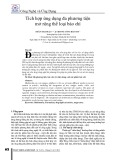
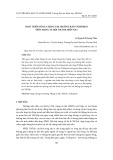

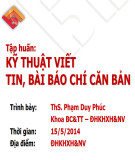
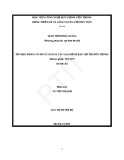
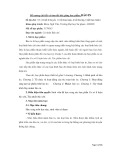
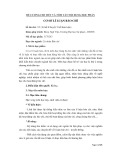


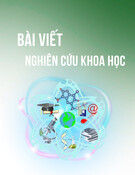
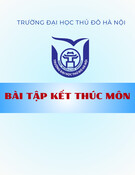
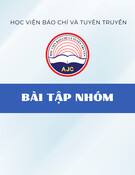
![Giáo trình Tác phẩm báo chí [mới nhất]](https://cdn.tailieu.vn/images/document/thumbnail/2025/20250813/tranhoangtinh2402199/135x160/30861755068459.jpg)

